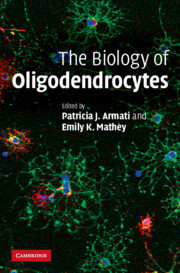Book contents
- Frontmatter
- Contents
- Preface
- Contributors
- 1 CNS oligarchs; the rise of the oligodendrocyte in a neuron-centric culture
- 2 Comparative biology of Schwann cells and oligodendrocytes
- 3 Control of oligodendrocyte development and myelination in the vertebrate CNS
- 4 Molecular organization of the oligodendrocyte and myelin
- 5 The genetics of oligodendrocytes
- 6 Immunobiology of the oligodendrocyte
- 7 Oligodendrocytes and disease: repair, remyelination and stem cells
- 8 Glial progenitor cells and the dynamics of the oligodendrocyte and its myelin in the aged and injured CNS
- 9 Oligodendroglial pathology in multiple sclerosis
- 10 Glutamate receptors, transporters and periventricular leukomalacia
- References
- Index
- Plate section
4 - Molecular organization of the oligodendrocyte and myelin
Published online by Cambridge University Press: 05 August 2012
- Frontmatter
- Contents
- Preface
- Contributors
- 1 CNS oligarchs; the rise of the oligodendrocyte in a neuron-centric culture
- 2 Comparative biology of Schwann cells and oligodendrocytes
- 3 Control of oligodendrocyte development and myelination in the vertebrate CNS
- 4 Molecular organization of the oligodendrocyte and myelin
- 5 The genetics of oligodendrocytes
- 6 Immunobiology of the oligodendrocyte
- 7 Oligodendrocytes and disease: repair, remyelination and stem cells
- 8 Glial progenitor cells and the dynamics of the oligodendrocyte and its myelin in the aged and injured CNS
- 9 Oligodendroglial pathology in multiple sclerosis
- 10 Glutamate receptors, transporters and periventricular leukomalacia
- References
- Index
- Plate section
Summary
INTRODUCTION
Oligodendrocytes are remarkable cells. In vertebrate evolution, the advent of oligodendrocytes and myelination transformed the CNS by allowing fast and energy efficient communication between neurons, ultimately fostering the evolution of animals with complex, highly integrated motor, sensory and cognitive functions. In humans, myelination underlies most of the early developmental neurological milestones, and new myelination continues to be important into the third and fourth decades. Human diseases involving oligodendrocyte dysfunction are devastating, and those such as multiple sclerosis (MS) account for a significant proportion of neurological disease. Since the first studies of myelin protein biochemistry in the late nineteenth century, myelin proteins and lipids have received intense experimental investigation. Extensive reviews of the biochemistry, genetics, immunogenicity and localizations of the major myelin proteins and lipids have been published. Recent genomic and proteomic studies have begun to provide a complete list of myelin and oligodendrocyte-enriched molecules. The goal of this chapter is to consider the contributions of different myelin proteins and lipids to (1) the structure of central nervous system (CNS) myelin, (2) the cell biology of myelin formation and (3) their roles in vital interactions between oligodendrocyte and axons. The emerging picture of oligodendrocyte myelination is a process that is extremely fault tolerant and inextricably intertwined with axonal function.
OLIGODENDROCYTES HAVE A HIGHLY POLARIZED SHAPE
Few cells have as extreme a shape as myelinating oligodendrocytes. Before discussing their molecular organization, it is therefore important to have a clear picture of oligodendrocytes and their myelin membranes.
- Type
- Chapter
- Information
- The Biology of Oligodendrocytes , pp. 64 - 102Publisher: Cambridge University PressPrint publication year: 2010
- 2
- Cited by



